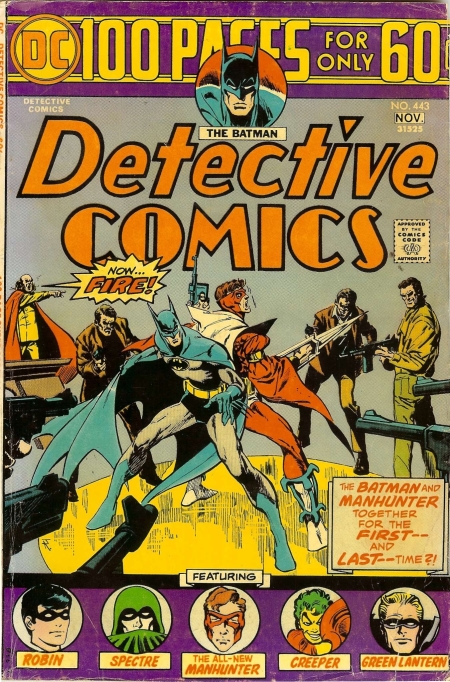
Cover of Detective Comics No. 443 ‘Batman and Manhunter together for the first — and last — time?! Art by Jim Aparo
One of the comic series that I’ve enjoyed re-reading is Manhunter by Archie Goodwin and Walt Simonson.
The “All-New” Manhunter ran just seven episodes, as a back-up feature in DC’s Detective Comics issues 437 through 443, published bi-monthly November 1973 through November 1974.
Manhunter is definitely a super-hero comic book – not particularly deep or thought-provoking, but I think it’s a cut above the somewhat formulaic fare of its time. The writing is intelligent; the pace and plot are good. In many of the chapters, the timelines are non-linear (think Tarantino’s Pulp Fiction), with plenty of flashbacks and backstories filling in background for the reader. There are clever surprising plot twists and a bit of contrasting humor. The seven-chapter story is a cohesive, building whole.
And the art is excellent. Walt Simonson has a distinctive style – comic-y, but just a bit stylized. Simonson, a bit like his contemporary Paul Gulacy, playing with panel shapes, pans, overlaps, camera zooms, and more – in a way that can be described as cinematic… though tranalated into and enriching the visual language of comics. From the Manhunter series on, Simonson was an artist who I liked and followed… though it’s been a while, so I forget what all he drew. Thor and Metal Men, I recall, and plenty of covers. Manhunter is one of those 1970s comic book franchise reboots that Alan Moore parodies in In Pictopia!. Since the 1970s, Manhunter has been retooled again and again (I guess it’s a temptingly good name for a comic book character), though I haven’t read those newer incarnations yet.
One of the earliest Manhunter incarnations began in the “Golden Age” circa the 1940s. Below are a couple of panels from this early incarnation (which I include mostly because they were reprinted in the same issue as one the All New Manhunter):
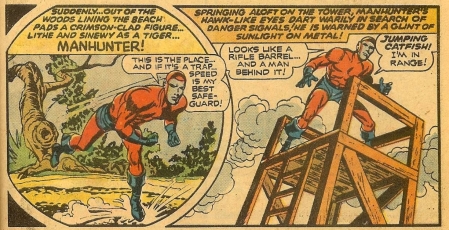
Panels from c.1940s ‘Manhunter battles Cobras of the Deep’ reprinted in Detective Comics No. 440, written by Joe Simon, drawn by Jack Kirby
I love the flowerly wordy language here “crimson-clad figure lithe and sinewy” whose “hawk-like eyes dart warily.” They don’t write comics like this any more.
The All-New Manhunter is a sort of clone reincarnation version of this older Manhunter, who was named Paul Kirk. I am not going to go into the All-New Manhuntet plot and origin all that much, though it’s good. Basically a revived Paul Kirk Manhunter is fighting against “the Council” a sort of all-encompassing international conspiracy cabal-thing that trained him before he turned against them. Manhunter has now-all-too-common superhero healing factor, plus some ninja weapons and guns.
Given that Manhunter was an 8-page back-up story, there ends up being quite a few small panels to squeeze the story into – often full of movement, and not a lot of text or dialogue. Where many comics have maybe roughly 2-8 panels per page, Manhunter has more like 8-12+ per page. I’m not sure if this is a fault or a feature… it might have worked better in a more expansive format, but you never know. Sometimes constraints force creators into places where they become more expressive and more successful.
Here’s a sample panel from the first chapter:
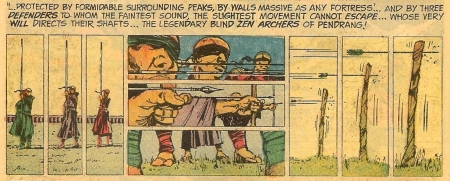
Nine-panel sequence from Manhunter, chapter 1, in Detective Comics No. 437, written by Archie Goodwin, drawn by Walt Simonson
Blind zen archers tell us that we’re indeed in comicbooklandia. Nonetheless, the sequence itself is full of art: great symmetry, strong cinematic verticals bracketing strong cinematic horizontals, all accentuated by the white gutters in between the panels (including two of the multi-panel pans that I wrote about here.)
Here’s another sequence:
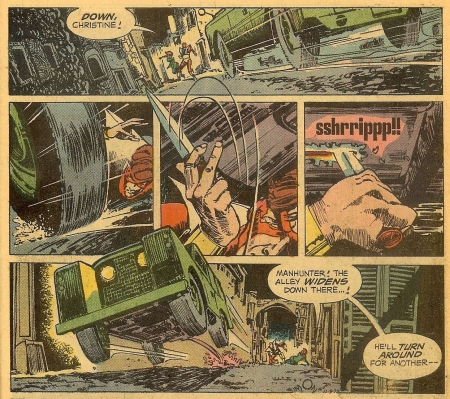
Five-panel sequence from Manhunter, chapter 4, in Detective Comics No.440, written by Archie Goodwin, drawn by Walt Simonson
Again, it’s mostly wordless; the fast-moving action is certainly shown, as opposed to described. The point of view is very dynamic, but feels like it’s shifting to tell a story, not just for effect. In panels 2-4 the viewpoint is tightly -cropped, giving the sequence a claustrophobic feel. Various panels include contents that stick out over the panel edges, and, while that’s been common for about 100 years, Simonson uses it to great effect. It’s one of the techniques that allows him to squeeze a lot action into a lot of panels on each page.
Note also Simonson’s distinctive signature on the bottom of panel five. Most of the time, most artists are just credited at the beginning of the story. It seems like Simonson is proud of this work, so he includes an extra signature, with date, nearly-hidden, somewhere in the stories he’s drawn.
My favorite Manhunter story is Chapter 5 Cathedral Perilous, originally published in Detective Comics No. 441. It takes place in Romulus Cathedral in Istanbul where the nefarious Council is meeting. Manhunter and his partner, then-rogue-Interpol-agent, Chirstine St. Clair, infiltrate the meeting. Fighting ensues. There’s a clever interplay between the main story and that of a comedic American tourist family that has also stumbled into the cathedral. The tourist parents don’t notice much that’s going on around them, but their young cowboy-playing son does and becomes integral to the story. Here’s a sequence:
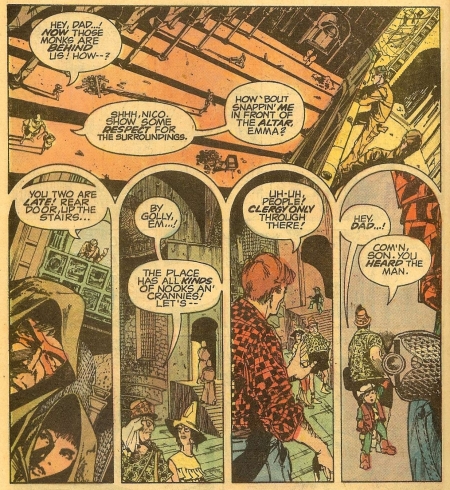
Five panel sequence from Manhunter, chapter 5, in Detective Comics No. 441, written by Archie Goodwin, drawn by Walt Simonson
The cool thing about these panels is that, with their arched tops, they echo the architecture of the cathedral. The panel gutters are transformed into pillars and arches. The tourists’ son notices the Council guard’s gun, though his parents are oblivious.
The big decisively-final conclusion of the All-New Manhunter series takes place in Detective Comics No. 443, (cover at top of post) where Manhunter teams up with Batman. The full-length Gotterdamerung story takes Manhunter from back-up feature to full-length cover story.
There are a few things I like about this story, that I will refrain from sharing, because they’re spoilers. I will say that I think that Walt Simonson draws a kick-ass Batman! Seems like a slightly styled Batman works better than a realistic one. Here’s a page from Detective Comics No. 443:
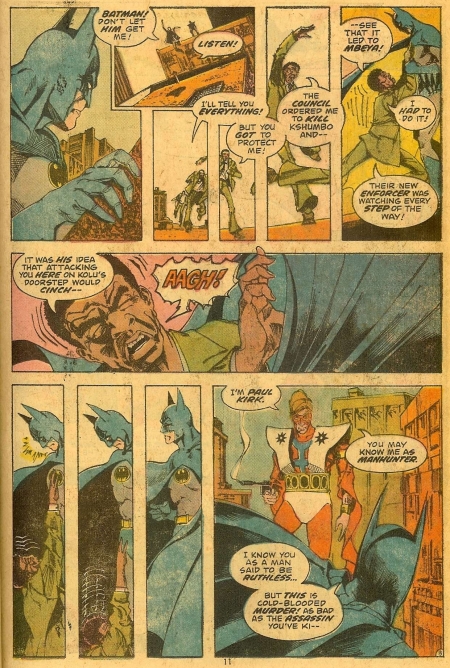
Page 11 of Detective Comics No. 443, Chapter 7 of the All-New Manhunter. Written by Archie Goodwin, drawn by Walt Simonson
The page flows really well visually.
Panels 3-6 are a multi-panel pan. It has the kind of overlaps (like Gulacy’s bottle sequence here), which is kind of cheating, but kind of works really well, too. There are five images of the assassin shown in four panels… so no panel actually indicates a precise snapshot. The overall progression appears as if it has been photographed with with a fish-eye.
My favorite part of the page is the three-panel sequence of panels 8-10. It’s a wordless fixed-camera sequence with tall slender panels that accentuate the vertical of the slain assassin’s fall. I like Batman’s head here, staring down at the assassin, somewhat stoically or maybe nonchalantly, then looking up at Manhunter. It’s subtle… and looking at it closely, I think that it’s slightly unlikely that it would actually take place like this… but I think it still works really well visually on the comic book page.
The ’70s Manhunter series has been collected in later DC reprints, trade paperbacks. Though they’re out of print, they’re not all that difficult to track down… and well worth it.
Tags: All-New_Manhunter, Archie_Goodwin, Detective_Comics, Manhunter, Walt_Simonson
7 February 2019 at 11:15am |
[…] platt till marken när Batman gästspelar i den sjunde och avslutande delen. Trots detta är det bättre än de flesta superhjälteserier på 1970-talet, inte minst för att den når ett definitivt […]
13 March 2019 at 10:08am |
Manhunter would make a great movie!
20 March 2019 at 2:27pm |
Awesome series from my childhood. Maybe the best comic series I read in 1974.
12 June 2020 at 3:56pm |
I recall a scene just as Manhunter is assembling a large sniper bazooka or similar, saying if he can just attach this stock, “there won’t be any ‘more’ “. The freshest-looking comic, I can’t believe it’s now getting on for 50 years old, or that on the entire internet this is the only reference I have found that is clearly to that strip with its free and easy movement.